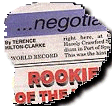

![]()
October 27, 2000
T n T's Promising Track Future
By TERENCE HILTON CLARKE
(THE HILTON CLARKE COLUMN)
THE performance of this country's track and field team at the World Junior Championships in Santiago, Chile was the ultimate reward for an outstanding generation of young athletes.
It is true that two bronze medals and a couple of fourth-place finishes will not be appreciated by most track and field giants, including Jamaica, but for a country whose history at the World Juniors, apart from Ato Boldon’s double-gold in 1992, has been non-descript, any appearance on the medals table is more than welcome.
In the context of what Trinidad and Tobago’s youngsters have done since 1998, the display is fitting. Not only has Trinidad and Tobago finished second to Jamaica at the last three Junior Carifta Games, but it has also joined the Jamaicans in occupying the top two positions at this years CAC Junior Championships in San Juan, Puerto Rico: thus cementing the notion that Trinidad and Tobago currently has the second top junior track and field team in the English-speaking Caribbean. Finally, one can throw in the silver medal earned by Candace Scott at last year’s Pan Am Junior Championships in Tampa, Florida (this country’s first medal at this meet in six years) as proof that Trinidad and Tobago had all bases covered going into the competition in Santiago.
Local officials had every right to be confident about the prospects of the team. Among the squad members was Fana Ashby, a former Carifta Games double-gold medallist and a 100 metres finalist at the previous World Junior Championships in Annecy, France in 1998. Along with Ashby, there were two other athletes that competed at the recent Sydney Olympics: Marc Burns and Damion Barry. Furthermore, there was Darrel Brown the 16-year old sensation who achieved double gold in the under-17 100 and 200 m in San Juan.
Ashby was duly expected to reach the 100 final once again and this she did, with interest: achieving a bronze medal with a time of 11.47 seconds, behind the gold medallist Veronica Campbell of Jamaica (11.12) and Germany’s Katchi Habel (11.39). Burns and Brown went on to finish 3-4 in the men’s 100 m final, both clocking 11:40, with Burns being given the edge for the bronze medal. Barry then followed his Sydney experience by finishing fourth in the men’s 400 m event with a time of 45.86. Unfortunately, luck did not appear to be on Trinidad and Tobago’s side in the men and women’s 200 m competitions, as well as the 4x100 m relay. But this country’s athletes had already made their presence known on the international athletics scene.
Certainly recognition must be extended not only to Trinidad and Tobago’s representatives in Santiago, but also to athletes such as Simon Pierre, Alicia Cave and Candace Scott who all made an impact over the last two years. Naturally, one must also pay homage to the respective coaches who helped guide the athletes to the positions that they attained. The major priority right now is establishing continuity: making sure that Trinidad and Tobago maintains and even improves its current flow of young talent. Of course, this will only come with the establishment of a comprehensive development program – something that will fall within the responsibility of the NAAA.
As relatively small countries
such as Jamaica, Cuba and the Bahamas have shown, track and field success
can be attained by anyone – once they are willing to devote the time and
the resources into developing top-level athletes.




